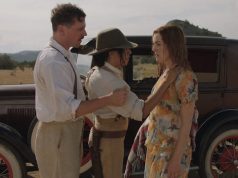“The Cat’s Meow” makes the point that Hollywood types look ridiculous, but they have so much fun doing it — and besides, if they didn’t look ridiculous, they wouldn’t be worth noticing at all.
The film is a little like that itself: it’s not a bad way to spend a couple hours, but it could have been something grand if it had just buckled down and tried a bit harder. That it bears many similarities to “Gosford Park” does not help it any; it lives in the shadow of that far-superior film.
It is based on a true incident, in which one of those Hollywood types died after a wild party on William Randolph Hearst’s yacht in 1924. The mystery of how he was killed and whether it was an accident was never solved; the film, written by Steven Peros and based on his play, purports to tell the version of things that is mostly commonly believed today.
It is an elite gathering on that boat, to be sure. Hearst (Edward Herrmann) is there, spying on his guests because he fears his mistress, the young actress Marion Davies (Kirsten Dunst), is cheating on him with none other than Charlie Chaplin (Eddie Izzard), who is also aboard. (Chaplin is beset by his own problems, of course, as one of his actresses has just come down with a severe case of pregnancy that she allegedly caught from Charlie.) Thomas Ince (Cary Elwes), a once-great film producer now fallen on hard times, is there, hoping to merge his interests with Hearst’s. One of Hearst’s newspaper columnists, Louella Parsons (Jennifer Tilly), is hanging around like a socially inept barnacle. Racy novelist Elinor Glyn (Joanna Lumley) is our narrator and commentator.
It is the Roaring ’20s, and decadence and frivolity are in full bloom aboard the ship. Marion, who is not having sex with Charlie Chaplin but who is not immune to his advances, either, is the quintessential flapper and the life of the party. If she cries out, “Charleston!,” then rest assured the band members will continue playing as they follow her and the other revelers out onto the deck for an impromptu moonlight dance. Bootlegged liquor flows freely.
And then someone gets killed. Lion’s Gate wants us not to mention who the victim is, which is curious, considering how relatively well-known the story is in the annals of Hollywood gossip. It’s sort of like asking us not to reveal whether the boat sinks or not in “Titanic.” Still, if the tale isn’t familiar to the reader, I will refrain from discussing it in detail.
As much as I love Kirsten Dunst, she is all wrong as Marion Davies. She’s too young, for one thing: Dunst was barely 19 when the film was shot, and Davies was 27 in 1924. At that age, that’s a huge difference, and the result is that Davies seems out-classed by the sophistication around her. (Louella Parsons is supposed to be the philistine, and Jennifer Tilly does a good job conveying that. But I kept thinking Davies was just as awkward.)
Turning in a fine performance, though, is Edward Herrmann as Hearst. The newspaper magnate is larger than life, the sort of man who shoots seagulls in flight just for the hell of it. But he also has heart and sensitivity, brought to bear when the murder occurs. (Sorry to spoil it for you if you thought Hearst would be the victim.)
The director is Peter Bogdanovich, and I can imagine him being very eager to tell this story. He is something of an authority on “Citizen Kane,” which of course was based loosely on Hearst’s life. (Bogdanovich, in fact, can be heard providing commentary on the “Citizen Kane” DVD, alongside Roger Ebert.)
He doesn’t allow his enthusiasm to overtake his storytelling, remaining instead very steady and calm. He employs, with cinematographer Bruno Delbonnel, a fly-on-the-wall style, allowing the camera to float through several scenes without cutting away, observing the rich and famous being themselves. (This visual style is one of several similarities to the aforementioned “Gosford Park.”)
But Bogdanovich does make the mistake of thinking the incident aboard the yacht will speak for itself, when in fact it could use a little life and personality infused into it. Not everyone, it must be remembered, is as fascinated with the story as he is. It’s a tale of intrigue and morality, but like the partiers it depicts, it refuses to acknowledge or deal with the weighty issues at hand. Instead, everybody just keeps on dancing.
B- (; )





